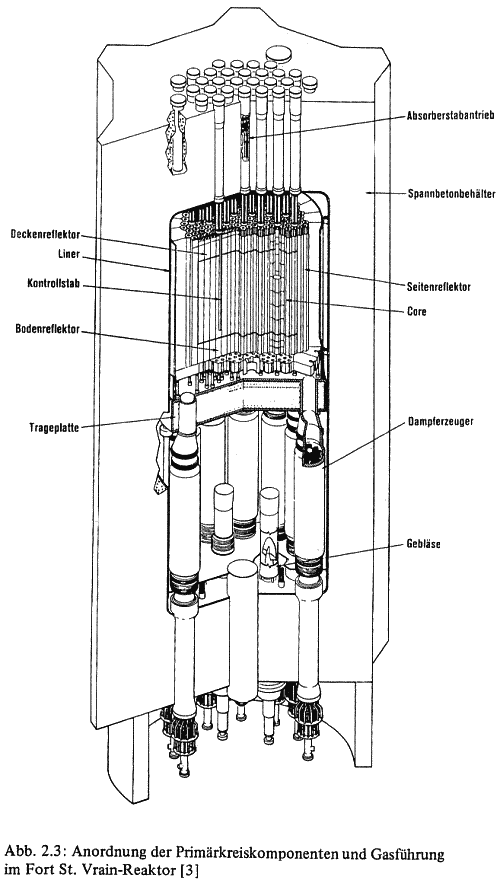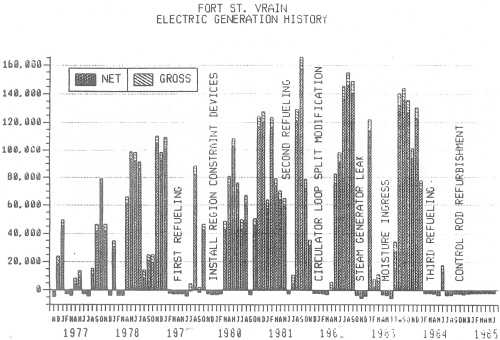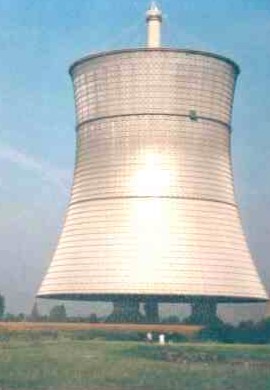| Geschichte | Videos und TV Beiträge |
| Geschichte der BI in Hamm | Zeitungsausschnitte |
| Fort St. Vrain - Der HTR Prototyp | Bücher zum Thema |
Fort St. Vrain
Der HTR Prototyp in den USA war auch schon ein Pleitereaktor
***
Das Dokument des Scheiterns aus dem Jahre 1985 wieder zugänglich:
Die Betreiber von HTR-Vorläufer Fort St. Vrain in den USA berichten über Probleme und Pannen
Die USA wollen verstärkt in dem Bereich der Hochtemperatur-Reaktoren forschen. Wir nehmen dies zum Anlass, auf die bisherigen schlechten Erfahrungen mit dem amerikanischen Vorläuferreaktor der HTR-Linie in Fort St. Vrain einzugehen und dokumentieren im Anschluss ein bisher öffentlich nicht zugängliches Originaldokument der damaligen Betreiber aus dem Jahre 1985, indem viele Probleme und Pannen während seiner Betriebszeit zugegeben werden.
Seit zwei Jahren wird immer deutlicher, dass der HTR in Südafrika keine Zukunft mehr hat. Die Pebble Bed Modular Reactor-Gesellschaft musste von ihren 800 Angestellten im März 2010 etwa 600 entlassen, weil der südafrikanische Staat ab diesem Zeitpunkt keine Zuschüsse mehr für das ins Strudeln geratene Projekt gab. Seit Monaten suchen die PBMR-Manager intensiv nach neuen Geldgebern.
*
Vollbild-Version der Karte der nuklearen Welt - Fort St. Vrain, Colorado USA
*
Rettet Obama den THTR?
Im März 2010 wurde bekannt dass das US-Energieministerium der PBMR-Gesellschaft 10 Millionen Dollar zukommen lässt, damit sie die nächsten Monate überstehen und den Betrieb notdürftig aufrecht erhalten kann.
Trotz dieser (verhältnismäßig kleinen) Finanzspritze kann höchstwahrscheinlich der PBMR unter diesen Umständen nur noch in den USA weiterentwickelt werden. Bereits im Januar 2009 sind die in Südafrika mit Hilfe deutscher Firmen hergestellten radioaktiven Kugelbrennelemente sang- und klanglos in die USA verschifft worden. Nach südafrikanischen Medienberichten wäre angeblich mit der Inbetriebnahme eines neuen PBMR 2024 in den USA zu rechnen. Die US-Regierung hat inzwischen zwei Gruppen mit insgesamt 40 Teilnehmern bewilligt, um sich mit dem Thema genauer zu befassen (1).
Es wäre sicherlich angebracht, wenn die US-Entscheidungsträger in der Energiepolitik sich endlich einmal mit den desaströsen Erfahrungen der eigenen "archaischen" Vorgänger des PBMR, Peach Bottom-1 und Fort St. Vrain, auseinandersetzen würden. Aber davon kann nicht die Rede sein. Am 16. Februar 2010 kündigte US-Präsident Obama an, nach langer Zeit wieder staatliche Kredite für Atomkraftwerke bereitzustellen und verstärkt in die Nuklearforschung einzusteigen.
Die USA sind bereits seit vielen Jahren Mitglied im "Generation IV International Forum" (GIF) und eine der treibenden Kräfte für die Weiterentwicklung der HTR-Reaktorlinie. Hierfür wurde viel Geld von staatlicher Seite zur Verfügung gestellt. Aufgrund des Rückstandes der HTR-Entwicklung kann sich für den Bau von HTR's bestenfalls nur eine mittelfristige Perspektive ergeben. Sogar der angeblich so fortschrittliche ehemalige US-Vizepräsident und selbsternannte Klimaschutzguru Al Gore hat sich in seinem neuesten Buch "Wir haben die Wahl" nicht unfreundlich zum THTR geäussert.
Obama und Al Gore sind natürlich nicht dumm. Selbstverständlich wissen sie um die energiepolitischen Flops der Vergangenheit in ihrem eigenen Land. Aber auch sie müssen die energiepolitischen Wünsche der Konzerne befriedigen. Bereits 20 Jahre vor (!) dem Scheitern des THTR's in Hamm-Uentrop wurde in den USA durch den Bau der Hochtemperaturreaktoren auf frappierende Weise die katastrophale Fehlentwicklung der gesamten Reaktorlinie bereits schon einmal durchexerziert! Und zwar mit dem Forschungsreaktor Peach Bottom-1 und dem HTR-Prototyp Fort St. Vrain.
***
Fort St. Vrain: Meist Stillstand
Ähnlich wie beim THTR in Hamm währte die Bauzeit bei dem Reaktor Fort St. Vrain (FSV) sehr lange. In ihm wurden keine Kugelbrennelemente, sondern Blockelemente eingesetzt. Das Ökoinstitut Freiburg berichtete 1986: "Der FSV-HTR wurde 1976 nach 11 Jahren Bauzeit in Betrieb genommen und konnte seither nicht kontinuierlich auf Vollast betrieben werden. Seit Jan. 1985 steht die Anlage erneut still und muß, wegen Auflagen des NRC, umfassend nachgebessert werden. Wieder einmal sich gravierende Fehler aufgetreten, z. B. sind 6 Abschaltstäbe aus ,unbekannten' Gründen nicht eingefahren. Ausserdem wurden Spannungskorrosionsrisse in den Steuerstabkabeln gefunden etc. ." (2)

Die Wissenschaftler aus Darmstadt ergänzten: "Fast von Anfang an durfte der FSV nicht mehr als 70% der vollen Leistung fahren aufgrund von Gasfluktuationen im Reaktorkern und Problemen mit dem Kühlgebläse sowie Unsicherheiten mit der garantierten Nachwärmeabfuhrleistung. Außerdem gab es bereits 1981 eine Undichtigkeit im Dampferzeuger sowie eine ganze Reihe zusätzlicher Probleme. So erreicht die Anlage vom Betriebsbeginn bis 1988 nur eine durchschnittliche Arbeitsverfügbarkeit von 14,5 %." (3)
Sogar Werner von Lensa (Vizepräsident des Europäischen Hochtemperatur Reaktor-Technologie Netzwerkes) kommt heute im Jahre 2010 nicht umhin, in seiner Präsentation unter "Erfahrungen" die Probleme im Fort St. Vrain zuzugeben:
"- Kavitation ("Aushöhlen", H. B.) der Wasserpumpen = ein Jahr Verzug
- Undichtigkeiten an He-Gebläse-Lager = weitere Verzögerungen
- Fehler an (Reserve-) Abschaltstäben
- Bypaß von heißem Helium und Korrosion an Abschaltstab-Antrieben
- Fluktuation der Coreströmung = 70 % Leistung
- Linerleaks an Core-Abstützung" (4)
*
250 Betriebsangehörige wurden evakuiert ...
Das alles ist noch gar nichts gegenüber dem, was Holger Strohm in seinem Bestseller "Friedlich in die Katastrophe" recherchiert hat: "Die Amerikaner hatten große Hoffnungen und viel Geld in die Entwicklung von Hochtemperaturreaktoren gesteckt. Mit dem Bau des Demonstrationsreaktors Fort St. Vrain mit ebenfalls 300 Mwel verschafften sich die Amerikaner 1973 einen Vorsprung. Anfang 1975 drangen jedoch mehrere Tonnen Wasser in das Core, so daß der Reaktor mehrere Jahre stillstand. Dieser Unfall gab dann Anlaß zu einer siebenbändigen Sicherheitsanalyse, die von der US-AAC in Auftrag gegeben worden war. In ihr wurden als mögliche Hauptursachen für Großunfälle ein großes oder mittleres Leck im Zwischenüberhitzer und ein Ausfall der externen Stromversorgung genannt.
Im Januar 1978 ereignete sich ein weiterer Unfall mit dem amerikanischen Hochtemperaturreaktor. Die Bundesregierung informierte auf Anfrage des Abgeordneten Zywietz (FDP) den Bundestag: "Im Kernkraftwerk Fort St. Vrain der Public Service of Colorado, welches mit einem heliumgekühlten Hochtemperaturreaktor ausgerüstet ist, wurde am 23. Januar 1978 gegen 11.30 Uhr (US-Ostküstenzeit) infolge Versagens der Spindelabdichtung eines Ventils Helium, das mit radioaktivem Jod durchsetzt war, in das Reaktorgebäude freigesetzt .... Als Folge von Notfallplänen wurden vorsorglich 250 Betriebsangehörige in das der Anlage gegenüberliegende Informationszentrum evakuiert und die umliegenden Straßen abgeriegelt. - Wassereinbrüche geschahen auch bei dem Versuchsreaktor in Jülich ..." (5)
Auch Greenpeace berichtete von einem weiteren Störfall am 3. Oktober 1987: "AKW Fort St. Vrain in Colorado: Auslaufendes Öl löst Feuer im Turbinenbereich aus. Kontrollraumleitungen, Ventile und Instrumente werden massiv beschädigt." (6)
*
Niedergang einer Reaktorlinie
Ulrich Kirchner stellt in seinem Standardwerk "Der Hochtemperaturreaktor" den Niedergang dieser Reaktorlinie in den USA folgendermassen dar: "In den Jahren 1974 und 1975 zogen die Energieversorgungsunternehmen in den USA aus verschiedenen Gründen alle Optionen für Hochtemperaturreaktoren zurück. Eine besondere Rolle spielten bei diesen Entscheidungen technische Probleme sowie Störfälle beim Fort-St.-Vrain-Reaktor, dessen erfolgreiche Inbetriebnahme als ,conditio sine qua non' (Bedingung, H. B.) der amerikanischen Markteinführung galt. Im Sommer 1989 beschloß die Betreibergesellschaft, daß der Reaktor seinen Betrieb nicht weiterführen sollte, obwohl eine Betriebszeit bis zum Jahre 2008 geplant gewesen war." (7)
Bis 1992 wurde Fort St. Vrain abgerissen und fand damit ein unrühmliches Ende. Mit Peach Bottom-1 und FSV haben sich die amerikanische Atomindustrie also zwischen 1962 bis 1992 ganze 30 Jahre lang herumgeschlagen und sich blamiert. Aber das zählt alles nichts. Die Industrie hat ihre Wünsche und die von ihr abhängigen Regierungsvertreter haben sie zu erfüllen. Deswegen werden jetzt von Barack Obama Milliarden Dollar für die Fortsetzung eines Nuklearabenteuers ausgegeben, dessen Ausgang absehbar ist.
Horst Blume
Anmerkungen:
- BusinessDay vom 30. 3. 2010
- Ökoinstitut Freiburg (Frey, Fritsche, Herbert, Kohler): "Der Thorium-Hochtemperaturreaktor in Hamm und die geplanten Hochtemperaturreaktor-Varianten", Seite 19
- Ökoinstitut Darmstadt, Siehe unter 2, Seite 2 - 4
- Werner Lensa, "Internationale Entwicklungsprogramme zum Hochtemperaturreaktor", Blatt 33
- Holger Strohm: "Friedlich in die Katastrophe", 1981, Seite 789; Kleine Korrektur zur Buchangabe: Der Wassereinbruch fand 1975, nicht 1973 statt.
- Greenpeace
- Ulrich Kirchner: "Der Hochtemperaturreaktor. Konflikte, Interessen, Entscheidungen", 1991, Seite 120
FORT ST. VRAIN UPDATE
Presented By 0. R. Lee
1985 Utility/User Conference on the HTGR
Introduction
Last year when I spoke to you, I described a plant upset which occurred in June, and involved six pairs of control rods not automatically inserting by gravity into the core as required upon receipt of a reactor shutdown signal.
We initiated actions to identify the cause of the event, clean up the six control rod drive assemblies, and anticipated returning the plant back to operation in September.
However, the discovery of stress corrosion cracking in the control rod drive cables and boric acid crystallization on the reserve shutdown material, as well as the lack of a definite failure mechanism being identified for the six control rods which did not insert into the core led to the decision to refurbish all of the control rod drive units and restore them to a "like new" condition.
This major undertaking, coupled with the discovery of a bearing water to interspace leak on one of the four helium circulators and subsequent disclosure of stress corrosion cracking in the holddown bolting of that circulator, extended the shutdown, and resulted in a rework effort unprecedented in the history of Fort St. Vrain. Consequently, the generator has remained off line for the last twelve months, reversing the upward trend we saw last year.
(Place Fort St. Vrain Electric Generation Graph on Screen and Discuss "Trend")
Operations
When we met a year ago, I reported to you that Fort St. Vrain had completed its third refueling, and the plant was restarted during the second week of June and brought to approximately 60% power until a plant upset on June 23rd terminated operations.
I will elaborate on the control rod drive rework effort, and describe other problems we encountered and resolved during this unique period.
Subsequent to the June 23rd event, we initiated actions to identify the root cause of the failure and restore the deficient control rods to an operable status. The six control rods that failed to insert were the first to be examined and rebuilt with additional control rods being examined and rebuilt afterwards. No definite cause of the failure could be identified, but indications were that shim motor bearing wear and debris buildup ,was the primary contributor.
During the course of our efforts, several other problems unrelated to the control rod failure were also identified.
One problem involved control rod instrumentation anomalies which began manifesting themselves, apparently induced by the high moisture content in the primary coolant.
Another consisted of a control rod absorber string suspension cable failure. 'The cable was evaluated, and stress corrosion cracking was identified as the failure mechanism.
The third problem was discovered during a test of a control rod drive reserve shutdown hopper. Test results disclosed that only 30 to 40 of the 80 pounds (nominal) of reserve shutdown material was expelled when the hopper was actuated. Inspection and chemical analysis of the material remaining in the hopper revealed boric oxide crystallization which facilitated bridging of the boron balls inside the hopper.
In order to implement a fix which would prevent a recurrence of the failures and problems encountered, the rigorous control rod drive refurbishment program began on February 22, 1985, and included:
- Refurbishment of all shim motors, orifice drives, and gear trains and replacement all motor bearings with new bearings,
- Replacement of all control rod instrumentation with new components, all stainless steel suspension cables with Inconel cables, and miscellaneous components with like components made from materials not as susceptible to chloride stress corrosion.
- Replacement of all reserve shutdown material with material which significantly reduces the amount of impurities available for conversion to boric acid crystals,
- Installation of temperature monitoring devices, and purge seals designed to inhibit primary coolant from entering the gear train and motor area.
The control rod drive refurbishment program was completed on June 24, 1985. Thirty-seven control rod drives have been completely refurbished and are in the reactor.
In September, 1984, moisture was found in a circulator penetration interspace. The carrier was determined to be a bearing water leak from one of the helium circulators to the interspace. This necessitated removal of the circulator for repair.
During the refurbishment of 'the circulator, stress corrosion cracking was discovered on the holddown bolting. The stainless steel bolting was replaced with lnconel bolting, and preparations were made for removal of the remaining three circulators to accomplish the bolting change-out.
By June, 1985, all four helium circulators had undergone the necessary bolting change-out and were reinstalled into the reactor.
In July, the NRC advised us that Fort St. Vrain could be restarted. Although we are limited to power levels less than 15 percent of rated thermal power, we are pursuing NRC authorization to operate at full rated power.
Regulatory Developments
Last year, I noted that there had been a distinct increase in regulatory involvement on both the state and federal level. That involvement is even more pronounced this year, and I would like to share with you our initiatives in dealing with selected issues.
- Last October, we received an NRC Assessment Report which contained a requirement that we use a third party consultinggroup to review our management structure and practices. To comply with this requirement, a consultant was hired to perform an analysis of the overall conduct of operations at Fort St. Vrain. After receiving the consultant's evaluation and recommendations, we took a number of important actions to deal with the issues raised in the consultant's report and in the earlier NRC Assessment Report. First of all, we carried out a major reorganization under which I now report directly to the President of our Company. To help conserve my time, we consolidated all fossil production activities under a new general manager position reporting directly to me. To improve our interaction with the NRC, we established a senior management communication link to the NRC.
- In response to the consultant's recommendations and to address NRC concerns, we have established a Performance Enhancement Program. As part of that program, we have identified six major projects with many sub-projects, through which we intend to:
1) Resolve organizational concerns.
2) Establish a' master planning and scheduling function for planned projects.
3) Incorporate a planning and scheduling function within the existing preventive maintenance function.
4) Upgrade nuclear policies and procedures, including the commitment control program.
5) Improve management and nuclear personnel training.
6) Improve the plant conduct of operations, particularly the NRC's observation regarding our failure to follow procedures.
These projects represent a major effort on our part to ensure that Fort St. Vrain achieves a consistent standard of excellence.
- Since 1979, we have submitted environmental qualification information to the NRC. We based these submittals on our understanding of 'how the regulations dealing with the environmental qualification of , safety-related V electrical equipment should be applied to a high temperature gas cooled reactor. Throughout this period, the NRC provided very little feedback. In January, 1985, we received a letter from the NRC requesting additional information to determine the extent of our compliance with the regulations. After numerous discussions, meetings, and exchanges of correspondence, we have been advised by the NRC that there are deficiencies in our program and that we will not be allowed to go to full power operation until we can demonstrate conformance to the applicable regulations. This NRC position, in effect, could disallow the qualification of all electrical equipment installed in a harsh environment at Fort St. Vrain. We have various studies and tests in progress, and are vigorously pursuing a resolution to this matter.
- Last year, I told you about a Colorado PUC decision under which we would be penalized for inadequate Fort St. Vrain performance by shifting excess costs of power production at Fort St. Vrain from the ratepayers to our shareholders. The potential refund under this order, which increases quite dramatically as long as Fort St. Vrain is nonoperational, was responsible for A $10.9 million charge against pretax income for the first six months of 1985. Although the Denver District Court issued an order setting aside the Colorado PUC decision, the matter has now been appealed to the' State Supreme Court.
Radiological
Once again, Fort St. Vrain topped the rest of the worldwide nuclear power industry with its exceptionally low personnel radiological exposure. The total exposure received by Fort St. Vrain personnel in 1984 was 3.11 person rem. This represents an increase from 0.95 person rem received in 1983, but is still well below the industry average for Light Water Reactors. This graph depicts the comparison of exposures for PWR's, BWR's, and Fort St. Vrain throughout this period.
The increase in 1984 at Fort St. Vrain is attributable to control rod drive maintenance and pre-refurbishment work, recognizing that the formal control rod drive refurbishment program was not begun until early in 1985.
Conclusions
We have encountered adversitles in the past. He are presently involved in a major evolution regarding environmental qualifications of equipment. We will undoubtedly be faced with other equally challenging problems in the future. Nevertheless, Public Service Company remains committed to Fort St. Vrain and to the technology and yexperience it can contribute to the nuclear industry.

Für die Arbeit an 'THTR Rundbrief', 'reaktorpleite.de' und 'Karte der nuklearen Welt' braucht es aktuelle Informationen, tatkräftige, frische Mitstreiter unter 100 (;-) und Spenden. Wer helfen kann, sende bitte eine Nachricht an: info@reaktorpleite.de
Spendenaufruf
- Der THTR-Rundbrief wird von der 'BI Umweltschutz Hamm' herausgegeben und finanziert sich aus Spenden.
- Der THTR-Rundbrief ist inzwischen zu einem vielbeachteten Informationsmedium geworden. Durch den Ausbau des Internetauftrittes und durch den Druck zusätzlicher Infoblätter entstehen jedoch laufend Kosten.
- Der THTR-Rundbrief recherchiert und berichtet ausführlich. Damit wir das tun können, sind wir auf Spenden angewiesen. Wir freuen uns über jede Spende!
Spendenkonto: BI Umweltschutz Hamm
Verwendungszweck: THTR Rundbrief
IBAN: DE31 4105 0095 0000 0394 79
BIC: WELADED1HAM
***



